Occasionally, some patients will experience an injury to the mouth during treatment. Dental emergencies while wearing braces or other orthodontic appliances generally fall into two categories.
EMERGENCIES RELATED TO ORTHODONTIC APPLIANCES
Sometimes, appliances might be broken or bent during your orthodontic care. If there are any disturbances, such as loose bands, loose brackets, or damaged or poking wires, please call our office for an appointment during patient hours. For your convenience and the convenience of scheduled patients, it is not possible to handle emergencies on a walk-in basis. In the meantime, here are some helpful hints to remedy some of the problems you may encounter until our office can see you.
True orthodontic emergencies are rare, but when they occur, we are available to you. As a general rule, you should call our office when you experience severe pain or have a painful appliance problem you can’t take care of yourself. We’ll be able to schedule an appointment to resolve the problem.
You might be surprised to learn that you may be able to solve many problems yourself temporarily until you can get to our office. If there is a loose piece that you can remove, put it in a plastic bag or envelope and bring it with you to your next appointment. If your braces are poking you, put soft wax on the piece that’s sticking out. If the wire has slid to one side, you can pull it back to the other side with needle-nosed pliers or tweezers, replacing it in the tube on the back tooth.
After alleviating your discomfort, it is essential that you still call our office as soon as possible to schedule a time to repair the problem. Allowing your appliance to remain damaged for an extended period may result in disruptions to your treatment plan or create undesired tooth movement.
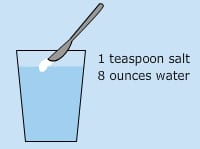
GENERAL SORENESS
When you get your braces on, you may feel general soreness in your mouth, and teeth may be tender to biting pressures for three to five days. Stick to a soft diet until your teeth do not hurt when chewing. Irritated gums and other sore spots can be relieved by rinsing your mouth with a warm, salt-water mouthwash. Dissolve one teaspoonful of salt in eight ounces of warm water and rinse your mouth vigorously. An alternative (better tasting) mouthwash is the Healthy Gums Rinse by The Natural Dentist. Placing Orabase on the affected area may also help relieve discomfort; Orabase can be found in a pharmacy. If the tenderness is severe, take Acetaminophen (Tylenol) or whatever you usually take for headache or similar pain. Aspirin, Ibuprofen (Motrin, Advil), and Naproxen Sodium (Naprosyn, Anaprox) actually slow tooth movement, so it is not advisable to use them frequently while wearing braces.
The lips, cheeks, and tongue may become irritated for one to two weeks as they learn a new posture and become accustomed to the surface of the braces. You can put wax on the braces to lessen this. We’ll show you how!
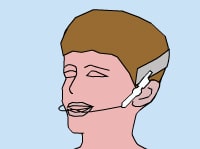
HEADGEAR
Sometimes, discomfort is caused by not wearing the headgear as instructed by your orthodontist. Please refer to the instructions provided by your orthodontist. If the face bow (metal piece) is bent, please call our office for assistance. The headgear should hurt less the more it’s worn, so be sure you wear it for the prescribed number of hours.
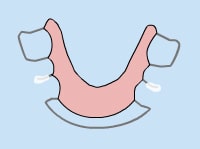
LOOSE APPLIANCE
If your appliance is poking you, place wax on the offending part.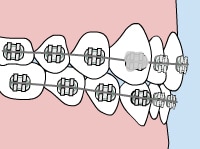
LOOSE BRACKET
If your bracket or band is still attached to the wire, you should leave it in place and put wax on it if needed for comfort. If the bracket or band can be removed easily, place it in an envelope and save it to bring to your next appointment.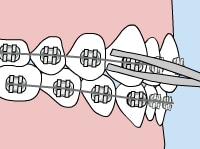
LOOSE WIRE
Using a pair of tweezers or needle-nosed pliers, try to put your wire back into place. It is okay to use a piece of floss to tie the wire into place: tie the floss around the bracket in place of the missing colored o-ring. If you cannot put the wire into a comfortable position and covering the end with wax doesn’t help, as a last resort, use a small fingernail clipper to clip the wire behind the last tooth to which it is securely fastened if the end of the wire is still sharp, place wax on it.
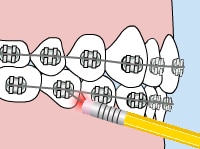
POKING WIRE
Using a pencil eraser, push the poking wire down or place wax on it so that it is no longer poking.
- If a tie wire is irritating your mouth, cover it with beeswax or tuck it under the arch wire with a blunt object like a pencil eraser or Q-tip.
- A loose band or bracket can generally be left in place until seen in our office. Call our office during patient hours when you notice a flexible band or bracket. If indicated, we will schedule you to reattach the loose appliance.
- A broken or poking archwire can often be bent in with a pencil erasure or cut with nail clippers. Call our office during patient hours if you do not feel the problem has been appropriately resolved.
DIRECT INJURIES TO THE MOUTH AND TEETH
Following a direct injury to your mouth or teeth, whether undergoing orthodontic care or not, immediately ice the injured area and you should contact your regular dentist as soon as possible. Usually an x-ray of the involved tooth or teeth is needed to determine the extent of injury. If a tooth has been displaced, knocked out, or fractured, it is best to contact your family dentist first, since we may not have the necessary materials or anesthesia required to treat these injuries. If the appliances are dislodged or displaced, we will need to replace or adjust the appliances as soon as possible, after you have seen your general dentist, depending upon the comfort level of the patient.
After Office Hours
If an orthodontic emergency arises where the patient is in pain after hours, please contact our office. Information is available regarding who to contact for further assistance.
